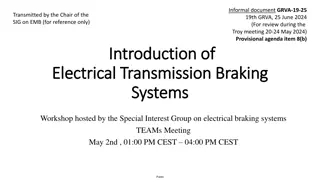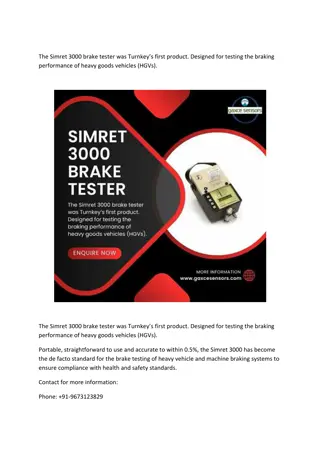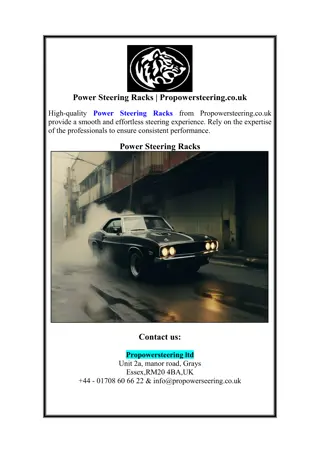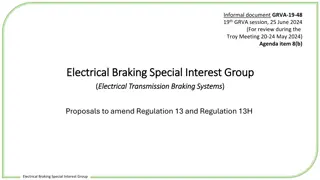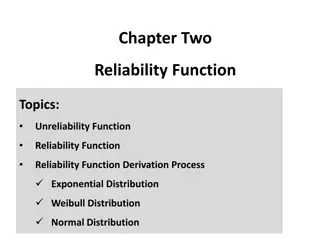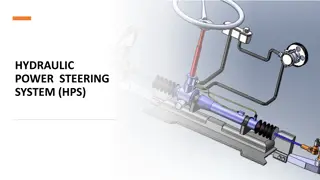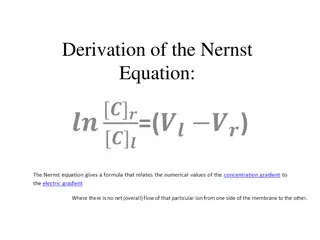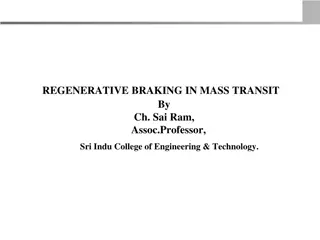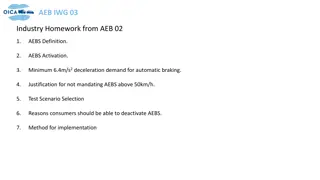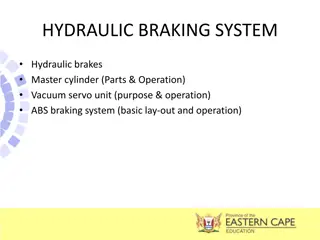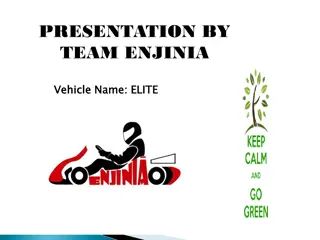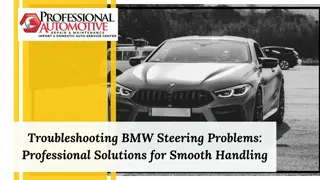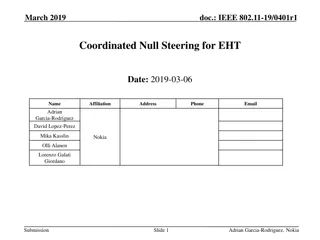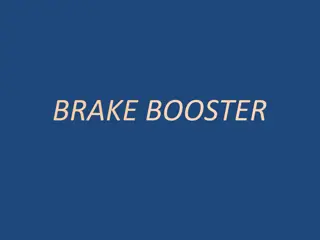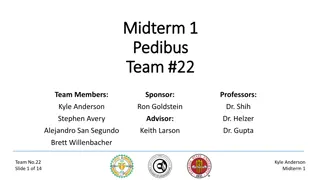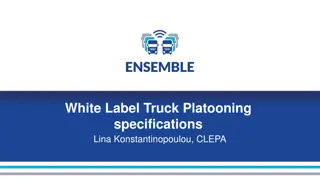Performance Requirements Derivation for Truck Braking and Steering
Daniel Sander from BASt, Germany, introduces a method to derive performance requirements from basic principles in the context of Last Point to Brake/Last Point to Steer for Trucks. The goal is to break down the definition of AEBS performance into key parameters, as exemplified in AEBS-M1-N1 for R152. Various references from the Informal Working Group AEBS-M1N1 are provided, along with concepts and assumptions for Car-Car and Car-VRU scenarios. The focus is on identifying possible speed reductions after Last Point to Steer based on brake system characteristics and physical models of the system, emphasizing the importance of defining performance requirements.
Download Presentation

Please find below an Image/Link to download the presentation.
The content on the website is provided AS IS for your information and personal use only. It may not be sold, licensed, or shared on other websites without obtaining consent from the author.If you encounter any issues during the download, it is possible that the publisher has removed the file from their server.
You are allowed to download the files provided on this website for personal or commercial use, subject to the condition that they are used lawfully. All files are the property of their respective owners.
The content on the website is provided AS IS for your information and personal use only. It may not be sold, licensed, or shared on other websites without obtaining consent from the author.
E N D
Presentation Transcript
Last Point to Brake/Last Point to Steer for Trucks Daniel Sander BASt, Germany 1
Goal Derive performance requirements from basic principles Break down definition of AEBS performance to a few parameters This method has been used in AEBS-M1-N1 (for R152) 3 Sander, BASt, Germany
Some References (from Informal Working Group AEBS-M1N1) GRVA-01-31: Speed reduction calculation sheet https://unece.org/DAM/trans/doc/2018/wp29grva/GRVA-01-31.zip AEBS-M1N1-03-04: LPB/LPS and pedestrian safety zone https://wiki.unece.org/download/attachments/54429506/AEBS-03- 04%20%28D%29%20Comments%20to%20skelton.pdf AEBS-M1N1-04-05: LPB/LPS and pedestrian safety zone (cont d) https://wiki.unece.org/download/attachments/60360943/AEBS-04- 05%20%28Germany%29%20D%20approach.pdf AEBS-M1N1-11-02: Bicycle brake performance https://wiki.unece.org/download/attachments/94046350/AEBS-11- 02%20%28D%29%20Bicycle%20braking%20performance.pdf 4 Sander, BASt, Germany
Concept from AEBS-M1-N1 (1) 0 1 Car-Car Scenarios (longitudinal conflict situations, vehicles moving in same direction) Braking possible at the latest at Last Point to Steer LPS TTCBrake Depends on vehicle width, possible ay Identify possible speed reduction after LPS with brake system characteristics Time to 1g - tTo1g Maximum deceleration - dmax 0 2 0 1 0 1 0 1 TTCBrake 0 1 0 1 Deceleration dmax tTo1g Time 5 Sander, BASt, Germany
From AEBS-02-11 6 Sander, BASt, Germany
TTCBrake Concept from AEBS-M1-N1 (2) Car-VRU Scenarios (lateral conflict situations, vehicle + VRU moving orthogonal) LPS not meaningful Brake at the latest when VRU is in vehicle path (evt. including safety zone/stopping dist) TTCBrake Depends on vehicle width, decel of VRU, impact location Identify possible speed reduction after LPS with brake system characteristics Time to 1g - tTo1g Maximum deceleration - dmax TTCBrake 01 7 Sander, BASt, Germany
Overall concepts and assumptions Do not define exact brake behavior! Define performance requirements (speed reduction) instead in order to leave the exact algorithm to the VMs Derive performance requirements from physical model of the system Ego vehicle should brake at the latest when avoidance per steering is not possible anymore ( TTC for the start of braking) At start of braking, increase brake decel linear until it reaches the maximum deceleration ( Time to 1 g) Maintain maximum deceleration until standstill ( d_max) 8 Sander, BASt, Germany
General Properties Tipping when turning Right wheel load is ?? ???,??? ?=1 2? ? ? ? ??? CoG m ? ? mg Tipping when right wheel load is 0: hCoG ? ? = ? 2 ??? w Example: Fwheel,right Fwheel,left 2 m 2 3mg = 0.33g ? = 9 Sander, BASt, Germany
Lateral Movement and Last Point to Steer Using Symetry: ?=???? 1 2 More appropriate for heavy vehicles due to poor lateral dynamics. ??2 ? ? = ?d? = ?=0 ?0 ? ????= 2 2?0 ? ????= ? ? ? ? ? ? ? ? ? ? ? 10 Sander, BASt, Germany
VRU Situation ??????= ??+? 2 ?? ? ????????= + ???? 2 ???? Truck Safety Zone can be interpreted as VRU stopping distance: ytotal w 2 ???? 2 ???? ??= ys Safety Zone vVRU ???? 2 ???? ? ????????= + 2 ???? 11 Sander, BASt, Germany
Deceleration of fully loaded N3-tractor-semitrailer combinations, 3 major brands (data: ADAC) 7 m/s 13 Sander, BASt, Germany
Time to 1 g 0.5 s from 0.83 s to 1.0 g Conservative: 1s 0 to 0.6 g 14 Sander, BASt, Germany
Vehicle width M2 N2 M3 N3 Vehicle width used for calculation: M2/N2: 2000 mm (due to small share in the accident situation) M3/N3: 2550 mm 15 Sander, BASt, Germany
Lateral Movement and Last Point to Steer ?0 ? ????= 2 Width M3/N3 limited to 2.55 m ? 2.55m 3m/s = 1.84s ????= 2 ? ? ? Width M2/N2 from 2 to 2.55 m ? ? 2m 3m/s = 1.63s ????= 2 16 Sander, BASt, Germany
Expected AEB Performance (using GRVA-01-31) Maximum Deceleration [m/s ] Time-To-1g [s] TTCBrake [s] 7 1 1,8 Expected AEBS Performance as Function of Test Speed 80 70 60 50 40 Speed Reduction [km/h] 30 Impact Speed [km/h] 20 10 0 10 15 20 25 30 35 40 45 50 55 60 65 70 75 80 85 90 95 100 105 110 12.5 17.5 22.5 27.5 32.5 37.5 42.5 47.5 52.5 57.5 62.5 67.5 72.5 77.5 82.5 87.5 92.5 97.5 102.5 107.5 Source: GRVA-01-31 Test Speed [km/h] 17 Sander, BASt, Germany
Results (brake when VRU in path) Parameter vVRU Value 5 km/h = 1,39 m/s (Ped) 15 km/h = 4,17 m/s 2 m (N2/M2) 2.55 m (N3/M3) Source UN-R152 N2/M2: Typical width N3/M3: EU Dimensions limit w ? ????????= 2 ???? Pedestrian 0.72 s (20 km/h*) 0.91 s (29 km/h*) Bicycle 0.24 s (1.5 km/h*) 0.3 s (2 km/h*) N2/M2 N3/M3 * Avoidance speed, calculated using GRVA-01-31 with 7 m/s peak deceleration, 1 s Time-to-1-g. 18 Sander, BASt, Germany
Parameter vVRU Value 5 km/h = 1,39 m/s (Ped) 15 km/h = 4,17 m/s 1,5 3 m/s (Ped) 4 5 m/s (Bicycle) Source UN-R152 Results (with safety zone) Ped: Tiemann, N., Branz, W., Schramm, D.: Predictive Pedestrian Protection Situation Analysis with a Pedestrian Motion Model . In: Proceedings of the 10th International Symposium on Advanced Vehicle Control. Loughborough, UK, 2010. Bicycle: AEBS-11-02 (AEBS-M1-N1= N2/M2: Typical width N3/M3: EU Dimensions limit aVRU ???? 2 ???? ? ????????= + 2 ???? 2 m (N2/M2) 2.55 m (N3/M3) w Pedestrian 1.03 s (35 km/h*) 1.09 s (38 km/h*) Bicycle 0.76 s (22 km/h*) 0.82 s (25 km/h*) N2/M2 N3/M3 * Avoidance speed, calculated using GRVA-01-31 with 7 m/s peak deceleration, 1 s Time-to-1-g. 19 Sander, BASt, Germany
Conclusions and Position
Possible Avoidance Speeds (up to) (Mitigation to be discussed later) Theoretical considerations; only few systems availabe. Vehicle Category Vehicle- Vehicle (DE Position) Vehicle- Pedestrian (Step 1)* 20 km/h 20 km/h 29 km/h 29 km/h Vehicle- Bicycle (Step 1) Vehicle- Pedestrian (Step 2)* 35 km/h 35 km/h 38 km/h 38 km/h Vehicle- Bicycle (Step 2)* 22 km/h 22 km/h 25 km/h 25 km/h N2 M2 N3 M3 65 km/h 65 km/h 75 km/h** 75 km/h** - - - - *It should be noted that these speed reductions are possible ONLY when the mandatory warning phase of 1.4s is removed. **Measurement data from production vehicles confirms these values. 21 Sander, BASt, Germany


